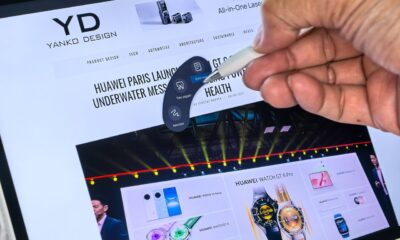Science
Concordia Researchers Unveil Real-Time Pathogen Tracking System
Researchers at Concordia University have introduced a groundbreaking method for tracking the spread of disease-causing particles, or pathogens, indoors. This innovative tool aims to enhance the monitoring of outbreaks, particularly in light of recent global health crises such as COVID-19. The findings were published in the journal Building and Environment.
New Tool Enhances Outbreak Response
The new method employs real-time camera and sensor-based tracking of infected individuals, combined with algorithmic models that assess air and pathogen dispersion. This dual approach not only evaluates infection risk levels but also allows ventilation systems to optimize airflow in real time, effectively reducing the potential for further infection.
Lead author and PhD candidate Zeinab Deldoost emphasized the efficiency of their system, stating, “Our novel method greatly reduces the simulation time found in other studies, giving us a better estimation of whether a location that has been exposed to pathogens still poses a risk.” Traditional models often focus on short bursts of airborne transmission—typically under a minute—while this new approach can simulate longer intervals of pathogen dispersion.
Co-author Fariborz Haghighat, a professor in the Department of Building, Civil and Environmental Engineering at the Gina Cody School of Engineering and Computer Science, noted the system’s capability to track infected individuals. “A building equipped with sensors allows us to follow the infected people and estimate or track who has been in contact with that person,” he explained.
Streamlined Calculations Improve Accuracy
The researchers’ approach simplifies airflow calculations by treating individuals as massless emission sources rather than estimating how their movements affect airflow. This method provides a consistent measure of airflow, enabling a more straightforward analysis of pathogen dispersion from moving sources.
Validation of this approach revealed that a person’s presence only briefly disrupts airflow. After an individual leaves a room, airflow typically returns to normal within approximately 40 seconds, with any disturbance extending only about one meter from their path. This finding indicates that the impact on pathogen dispersal over larger areas and longer durations is minimal.
This improved technique can simulate one second of pathogen dispersion in just 3.8 seconds on a standard laptop. This efficiency is particularly advantageous for dynamic environments such as hospitals, where decision-makers can make informed choices in near real-time.
Co-author Fuzhan Nasiri, also a professor in the same department, believes that this simulation could pave the way for broader adoption of dispersion-response models in various building types. “If we could use this simulation over an extended period under different scenarios, we could generate enough data to represent various patterns of movement and pathogen dispersion,” he stated. “That dataset could then be used to train AI systems, allowing future users to avoid running complete simulations to achieve similar results.”
This research was supported by a grant from the Natural Sciences and Engineering Research Council of Canada, marking a significant advancement in the field of indoor air quality and public health preparedness.
For further details, the cited article is titled “Real-time analysis of pathogen dispersion patterns resulting from a moving infectious person.”
-

 Education3 months ago
Education3 months agoBrandon University’s Failed $5 Million Project Sparks Oversight Review
-

 Science4 months ago
Science4 months agoMicrosoft Confirms U.S. Law Overrules Canadian Data Sovereignty
-

 Lifestyle3 months ago
Lifestyle3 months agoWinnipeg Celebrates Culinary Creativity During Le Burger Week 2025
-

 Health4 months ago
Health4 months agoMontreal’s Groupe Marcelle Leads Canadian Cosmetic Industry Growth
-

 Technology3 months ago
Technology3 months agoDragon Ball: Sparking! Zero Launching on Switch and Switch 2 This November
-

 Science4 months ago
Science4 months agoTech Innovator Amandipp Singh Transforms Hiring for Disabled
-

 Education3 months ago
Education3 months agoRed River College Launches New Programs to Address Industry Needs
-

 Technology4 months ago
Technology4 months agoGoogle Pixel 10 Pro Fold Specs Unveiled Ahead of Launch
-

 Business3 months ago
Business3 months agoRocket Lab Reports Strong Q2 2025 Revenue Growth and Future Plans
-

 Technology2 months ago
Technology2 months agoDiscord Faces Serious Security Breach Affecting Millions
-

 Education3 months ago
Education3 months agoAlberta Teachers’ Strike: Potential Impacts on Students and Families
-

 Science3 months ago
Science3 months agoChina’s Wukong Spacesuit Sets New Standard for AI in Space
-

 Education3 months ago
Education3 months agoNew SĆIȺNEW̱ SṮEȽIṮḴEȽ Elementary Opens in Langford for 2025/2026 Year
-

 Technology4 months ago
Technology4 months agoWorld of Warcraft Players Buzz Over 19-Quest Bee Challenge
-

 Business4 months ago
Business4 months agoNew Estimates Reveal ChatGPT-5 Energy Use Could Soar
-

 Business3 months ago
Business3 months agoDawson City Residents Rally Around Buy Canadian Movement
-

 Technology2 months ago
Technology2 months agoHuawei MatePad 12X Redefines Tablet Experience for Professionals
-

 Business3 months ago
Business3 months agoBNA Brewing to Open New Bowling Alley in Downtown Penticton
-

 Technology4 months ago
Technology4 months agoFuture Entertainment Launches DDoD with Gameplay Trailer Showcase
-

 Technology4 months ago
Technology4 months agoGlobal Launch of Ragnarok M: Classic Set for September 3, 2025
-

 Technology4 months ago
Technology4 months agoInnovative 140W GaN Travel Adapter Combines Power and Convenience
-

 Science4 months ago
Science4 months agoXi Labs Innovates with New AI Operating System Set for 2025 Launch
-

 Top Stories2 months ago
Top Stories2 months agoBlue Jays Shift José Berríos to Bullpen Ahead of Playoffs
-

 Technology4 months ago
Technology4 months agoNew IDR01 Smart Ring Offers Advanced Sports Tracking for $169










